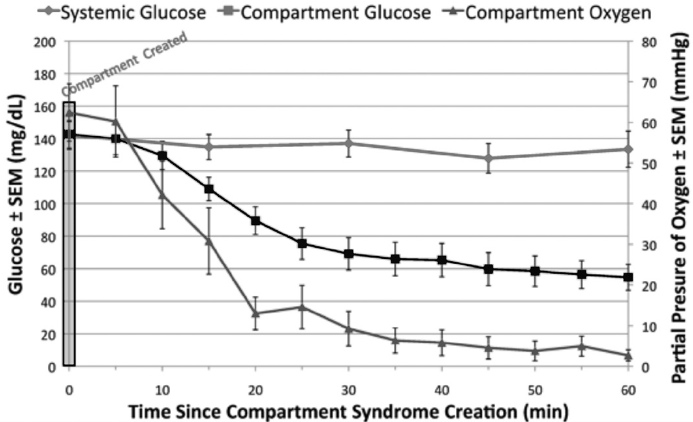
Fri., 10/5/12 Basic Science, PAPER #51, 1:12 pm OTA-2012
Can Glucose Levels Diagnose Compartment Syndrome?
Christopher J. Doro, MD1; Thomas J. Sitzman, MD2; Robert V. O’Toole, MD3;
1Department of Orthopaedics, University of Wisconsin School of Medicine and Public Health, Madison, Wisconsin, USA;
2Division of Plastic Surgery, University of Wisconsin School of Medicine and Public Health, Madison, Wisconsin, USA;
3R Adams Cowley Shock Trauma Center, Department of Orthopaedics,
University of Maryland School of Medicine, Baltimore, Maryland, USA
Purpose: Compartment syndrome is a difficult condition to diagnose, particularly in patients without a reliable clinical examination. Current objective methods rely on intracompartmental pressure measurements. We hypothesize that intracompartmental glucose levels can be used to diagnose compartment syndrome.
Methods: A compartment syndrome was created in 12 adult mixed-gender beagles using a previously described and validated model. Compartment syndrome was created in the anterior compartment of a lower leg in anesthetized dogs by infusion of lactated Ringer’s solution with normal serum concentration of glucose until intracompartment pressure exceeded 20 mm Hg above diastolic blood pressure. The contralateral leg was used as a control. Intracompartmental pressure, oxygen tension, and glucose concentration were recorded within each compartment using commercially available probes (Medtronic Diabetes; Oxford Optronix). Compartment syndrome was confirmed in all cases by histologic analysis at 2 weeks after the infusion.
Results: Within 15 minutes of creating the compartment syndrome, glucose concentration in the experimental limb measured significantly lower than the control limb (glucose P = 0.02; 2-tailed t test). Intramuscular glucose concentration less than 97 mg/dL was 100% (95% confidence interval [CI]: 73%-100%) sensitive and 75% (95% CI: 40%-94%) specific for the presence of compartment syndrome.
Conclusion: Our results show that the intracompartmental glucose concentration appears to rapidly identify muscle ischemia after an experimentally created compartment syndrome. Real-time glucose sensors could provide a significant advancement to the diagnosis of compartment syndrome by providing objective data that accurately and quickly indicate the presence of muscle ischemia, as opposed to relying on pressure measurements that are a much less direct indicator of ischemia.

Alphabetical Disclosure Listing (808K PDF)
• The FDA has not cleared this drug and/or medical device for the use described in this presentation (i.e., the drug or medical device is being discussed for an “off label” use). ◆FDA information not available at time of printing. Δ OTA Grant.